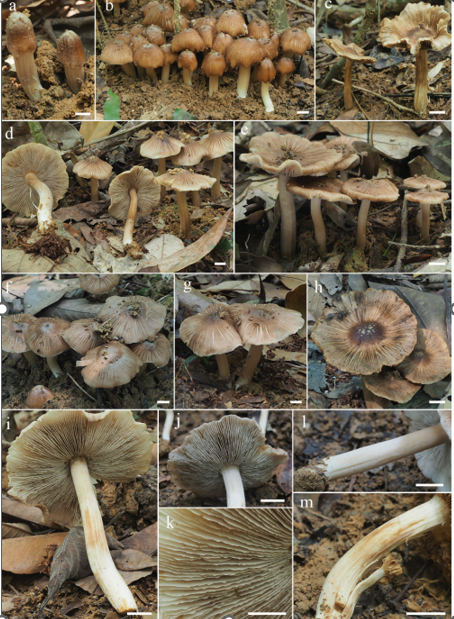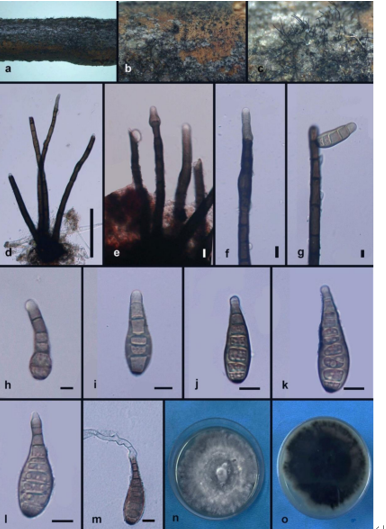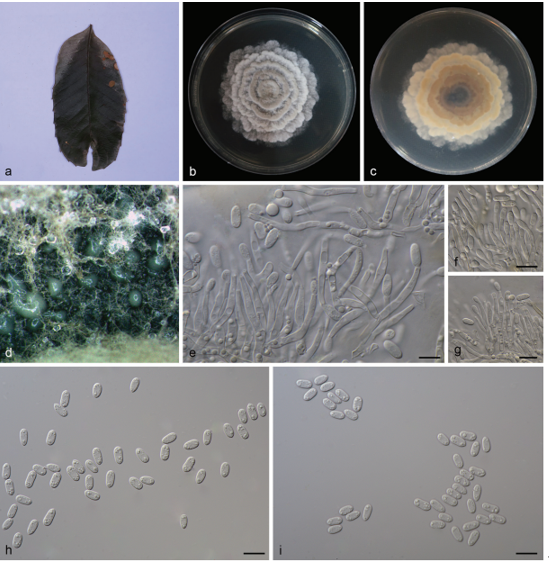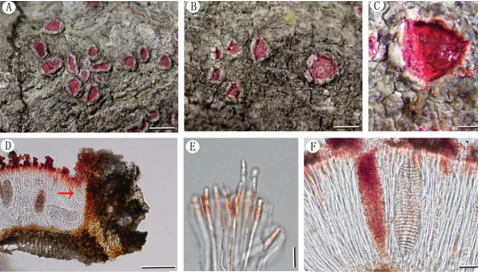Anthracina saxincola L. Su, W. Sun and M.C. Xiang, sp. nov. 2020
MycoBank MB 810885
Holotype: China: Yunnan Province: Lijiang City, Yulong Naxi Autonomous County, Jade Dragon Snow Mountain, plateau landscape, 27◦160 N, 100◦110 W, 3250 m a.s.l., from sandstone, 15 January 2013, Lei Su, (HMAS245365 (dried culture)—holotype and CGMCC 3.17315—ex-type culture).
Morphological description
Hyphae moniliform, branched, pale brown to dark brown, 0.8–5.5-µm-wide(x = 2.7 µm, n = 20), abundant oil drops in young hyphae, enteroblastically proliferating, pale brown at first, yellowish brown when aged (Figure 7D,E). Swollen cell (Figure 7F, arrow) spherical to ellipsoidal, 9.8–16.4 µm in diam. (x = 14.5 µm, n = 10), formed by intercalary or terminal. Unicellular (Figure 7G) and multicellular bodies (Figure 7H–J) globose to ellipsoidal, brown, 5.2–9.2 × 9.2–15.8 µm (x = 6.8 × 13.5 µm, n = 10). Endoconidia (arrow in Figure 7K) were occasionally observed in enlarged cells or in multicellular bodies.Culture characteristics: Colonies on MEA extremely slow-growing, attaining 4-mm-diam. after 20 weeks at 25 ◦C, compact, center-raised, deep olive-gray to olive-black, with scant, velvety aerial mycelia, flat and glossy near the periphery; black in reverse (Figure 7A–C). Minimum 4 ◦C, optimum at 20–25 ◦C, and maximum 30 ◦C.
Habitat: from sandstone
Distribution: China
GenBank Accession:
Notes: The cylindrical, ampulliform, and obovate hyphae of A. saxincola apparently differ from other genera, such as Knufia, Bradymyces, and Trichomerium [22,24,27,28,32], in the same family. A. ramosa and A. saxincola were clustered into a clade with strong bootstrap support (MLBP/BIPP = 100%/1.00) (Figure 2). However, the growth rate of A. ramosa is much faster (14 mm in 20 weeks on MEA at 25 ◦C) than that of A. saxincola (4 mm in 20 weeks on MEA at 25 ◦C). A. saxincola also produced multicellular bodies in the aged cultures, and endoconidia were also occasionally observed in enlarged cells or in multicellular bodies, while those were not observed in the culture of A. ramosa.
Reference: Wei Sun , Lei Su , Shun Yang et al.
Anthracina saxincola (CGMCC3.17315). (A–C) Colony forward and reverse after 20 weeks on
MEA. (D,E) Different hyphal morphologies. (F) Swollen cell (arrow). (G) Unicellular body with hypha. (H–J) Solitary, enlarged, dark-pigmented multicellular bodies. (K) Endoconidia in intercalary cells of hyphae (arrow). Scale bars (C) = 50 µm and (D–K) = 10 µm.









